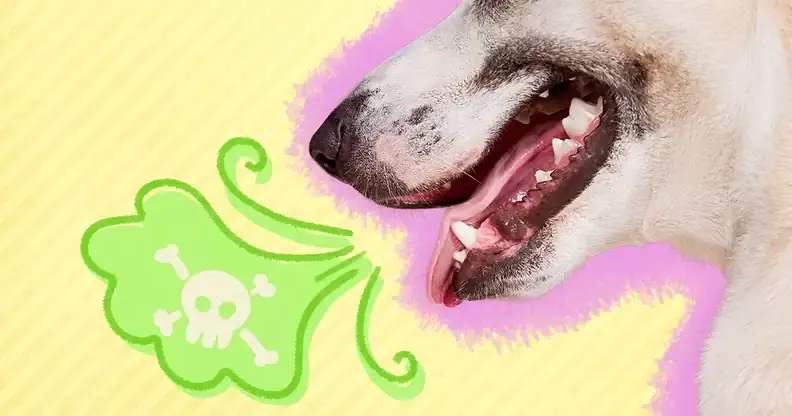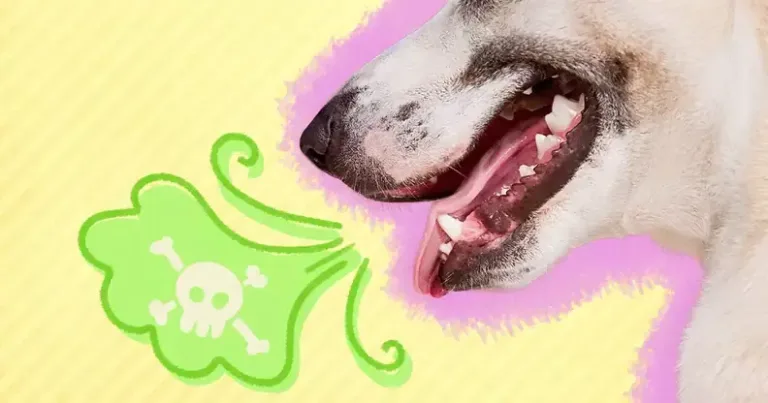Dog bad breath, or halitosis, is a common concern among pet owners, yet it often signifies underlying health issues ranging from minor problems like tartar buildup and gingivitis to more serious conditions such as diabetes, kidney disease, or liver disease. While bad breath in dogs might seem like a trivial matter, it can be an important indicator of your pet’s overall health, making it essential not just for comfort but also for preventive healthcare. Addressing this issue promptly can help in avoiding the development of potentially severe dental and systemic health problems.
This article will guide you through understanding the causes of dog bad breath, including the role of tartar, gum disease, tooth decay, and how systemic diseases like diabetes, jaundice, and malocclusions contribute to the condition. It will further explore home remedies for freshening your dog’s breath, essential diet and lifestyle adjustments, and the importance of regular dental hygiene practices, such as brushing teeth. Additionally, it will shed light on professional treatments and when it is crucial to consult a vet, considering the risks of periodontal disease, kidney disease, liver disease, and oral cancers. Through these insights, owners can take proactive steps in maintaining their dog’s oral health and wellbeing.
Dog Bad Breath
Causes of Bad Breath in Dogs
Oral Health Issues
Oral health issues are a predominant factor contributing to bad breath in dogs. These issues encompass a variety of conditions including tooth decay, gum disease, and oral infections. The accumulation of bacteria and food debris over time, if not regularly cleaned, results in plaque formation and a persistent bad odor . Poor dental hygiene can lead to periodontal disease, where plaque spreads onto the gum causing inflammation and infection. This condition not only results in bad breath but can escalate to more serious health problems such as tooth loss and even systemic infections affecting vital organs .
Kidney and Liver Disease
Bad breath in dogs may also indicate more serious health issues such as kidney or liver disease. A breath that smells like urine can be a sign of kidney disease, where the kidneys fail to properly filter toxins, leading to an accumulation that can cause a foul odor. Similarly, liver disease might be suggested by a foul breath accompanied by symptoms like vomiting, diarrhea, and jaundice. The liver’s inability to filter toxins effectively can lead to an accumulation of waste products, contributing to the bad breath .
Dietary Factors
Diet plays a crucial role in the oral health of dogs. High carbohydrate diets can lead to an increase in bacteria in the mouth as dogs lack the enzyme amylase, which helps in breaking down these carbohydrates before they can harm the teeth. This can result in higher bacterial growth and bad breath . Feeding dogs with diets approved by the Veterinary Oral Health Council can help manage plaque and tartar buildup, thereby improving breath quality and overall dental health .
Home Remedies for Freshening Dog Breath
Tooth Brushing Techniques
Regular tooth brushing is essential for maintaining your dog’s oral health. Start by allowing your dog to get accustomed to the toothbrush without toothpaste, and gradually introduce dog-specific toothpaste, which is formulated to be safe and appealing to dogs . Brushing should be done gently, focusing on the crown of the teeth without irritating the gums. It is recommended to brush your dog’s teeth daily, but even a routine of a few times a week can significantly reduce plaque and prevent tartar buildup .
Use of Yogurt and Probiotics
Incorporating plain yogurt into your dog’s diet can be beneficial due to its probiotic content, which helps maintain a balance of beneficial bacteria in your dog’s mouth and digestive system . When selecting yogurt, opt for brands that are low in lactose and free from harmful additives like xylitol, as many dogs are lactose intolerant. Additionally, probiotics can be supplemented daily to combat the bacteria causing bad breath .Dog Bad Breath
Chew Toys and Treats
Chew toys are not only fun for dogs but also serve an important role in dental health. Toys designed for dental care, such as those infused with baking soda toothpaste or those with a texture that cleans the teeth and gums, can significantly reduce plaque and freshen breath . Rubber chew toys with hollow centers can be filled with breath-freshening ingredients, providing both entertainment and oral care benefits . Additionally, offering your dog crunchy treats like apple slices and carrots can help mechanically clean teeth and freshen breath . Dog Bad Breath
Diet and Lifestyle Adjustments
Healthy Foods and Snacks
Incorporating fresh, crunchy vegetables like baby carrots, sliced apples (without the seeds), cucumbers, and celery into a dog’s diet can significantly improve their dental health. These snacks are not only low in calories but are rich in nutrients and possess a natural crunch that helps clean teeth by removing food particles and plaque . Additionally, treats containing natural ingredients such as chlorophyll, cinnamon, or cloves can be beneficial. These ingredients are known for their antibacterial properties and can help in eliminating odor-causing bacteria in the dog’s mouth . For dogs with specific dental needs, high-quality large breed kibble designed to encourage chewing can be effective in reducing plaque buildup .
Avoiding Toxic Substances
It is crucial for dog owners to be aware of toxic substances that can harm their pets. Xylitol, an artificial sweetener found in many human foods, is extremely toxic to dogs and can cause severe health issues such as blood clotting disorders and seizures . Owners should ensure that any treats or foods given to their dogs are free from xylitol and other harmful substances. Additionally, while coconut oil is often touted for its health benefits, including antibacterial properties, it should be used with caution. Only small amounts should be added to a dog’s diet to avoid any adverse effects . Dog Bad Breath
Professional Treatments and When to See a Vet
Signs to Watch For
Recognizing early signs of dental issues in dogs is crucial for timely intervention. Owners should be vigilant for symptoms such as refusal to eat or changes in eating habits, which may indicate pain during eating . Bad breath, especially if sudden, can be a sign of an underlying infection . Observing gums that bleed easily or are red and swollen can also signal gum disease or infections . Additionally, excessive drooling or unusual behaviors such as depression or lethargy could be signs of discomfort due to oral health problems . If any of these symptoms are noticed, it’s essential for the dog to be examined by a veterinarian promptly to prevent the progression of dental diseases and associated health complications.Dog Bad Breath
Veterinary Dental Cleanings
Regular veterinary dental cleanings are a cornerstone of maintaining a dog’s oral and overall health. During a professional cleaning, the veterinarian performs a full tooth-by-tooth examination under anesthesia, which allows for a thorough cleaning and assessment of the dog’s oral health . This process includes removing plaque and tartar from above and below the gum line, probing and x-raying the teeth, and applying fluoride treatments and dental sealants to protect against future decay . Regular cleanings not only freshen a dog’s breath but also reduce the risk of developing serious health issues like cavities, gum disease, and potentially heart disease due to bacterial spread from oral infections . For dogs showing signs of advanced periodontal disease, a customized treatment plan is developed to restore oral health, which can significantly improve their quality of life .
Conclusion
Through the exploration of causes, remedies, and preventative measures, this article has underscored the importance of addressing dog bad breath not merely for aesthetic reasons but as a vital aspect of maintaining your pet’s health. From the significance of regular dental hygiene practices to recognizing the symptoms that necessitate professional veterinary intervention, it is clear that a proactive stance towards oral care can prevent a range of serious health issues. Diet adjustments and proper dental care routines stand out as fundamental steps in preserving the well-being of our furry friends, highlighting the role of responsible pet ownership in their health.
In essence, the journey towards combating bad breath in dogs opens up a broader conversation about the link between oral hygiene and overall health in pets. By adhering to the guidelines presented, including regular brushing, dietary considerations, and the timely seeking of professional advice, pet owners can ensure their dogs not only enjoy fresher breath but also a higher quality of life. It encapsulates a commitment to nurturing the bond between pets and their owners through the lens of comprehensive healthcare, fostering a deeper understanding of the responsibilities entailed in pet care.Dog Bad Breath
FAQs
There are no frequently asked questions available at this time regarding simple steps to prevent dog bad breath. Please check back later for updates or more information.


